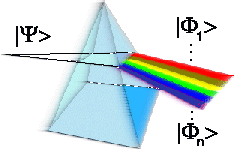Demascoth Kadio, Mariusz Gajda and Kazimierz Rzążewski
We investigate the phase fluctuations of a Bose-Einstein condensate in one- (1D) and three-dimensional (3D) elongated harmonic traps with the help of the numerical simulation using classical field approximation. By calculating the eigenvalues of the one-dimensional single-particle density matrix we show that the phase fluctuations of a Bose-Einstein Condensate in a 1D system are due to the thermal low-energy excitations. We find that the phase fluctuations depend on the temperature as has been predicted [Phys. Rev. Lett. 85, 3745 (2000), Phys. Rev. Lett. 87, 050404 (2001)]. Finally we show that the phase coherence length of a condensate in a harmonic trap depends on the aspect ratio of anisotropy (geometry) of the trap. We determine the border between the 3D and quasi-one-dimensional systems by calculating the phase coherence length of the condensate.
Phys. Rev. A 72, 013607 (2005)
Jul 11, 2005
Criterion for Bose-Einstein condesation in a harmonic trap in the case with attractive interactions
Mariusz Gajda
Using a model many-body wave function I analyze the standard criterion for Bose-Einstein condensation and its relation to coherence properties of the system. I pay special attention to an attractive condensate under such a condition that a characteristic length scale of the spatial extension of its center of mass differs significantly from length scales of relative coordinates. I show that although no interference fringes are produced in the two-slit Young interference experiment performed on this system, fringes of a high visibility can be observed in a conditional simultaneous detection of two particles.
Phys. Rev. A vol. 73, 023603 - 1-5 (2006) [1/1]
Using a model many-body wave function I analyze the standard criterion for Bose-Einstein condensation and its relation to coherence properties of the system. I pay special attention to an attractive condensate under such a condition that a characteristic length scale of the spatial extension of its center of mass differs significantly from length scales of relative coordinates. I show that although no interference fringes are produced in the two-slit Young interference experiment performed on this system, fringes of a high visibility can be observed in a conditional simultaneous detection of two particles.
Phys. Rev. A vol. 73, 023603 - 1-5 (2006) [1/1]
Subscribe to:
Comments (Atom)
